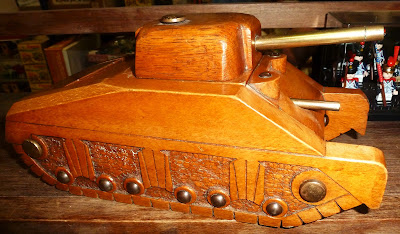Two weeks after the event and I am just recovering from the toy soldier overload that is the annual Plastic Warrior Show, I still haven't unpacked the bags and boxes of plunder I acquired but no doubt they'll surface here sooner or later. In the meantime here are a few gratuitous pictures of plastic toy soldiers to remind those those who were there on the day and to drool over for those who were not.
When I have a little money, I buy Toy Soldiers; and if I have any left, I buy food and clothes. (with apologies to:) ERASMUS
Saturday, 21 June 2025
Lots of toy soldiers at the Plastic Warrior Show 2025
Wednesday, 14 May 2025
Assorted Ancients now on display.
Following on from the previous post, here are closeups of the second new shelf. The shelves are inside a pine wardrobe built into a chimney alcove, long since unfit for purpose but I'm averse to ripping out period features so it now houses toy soldiers and the original doors provide some protection from the dust.
Friday, 11 October 2024
Fleamarket finds from the weekend.
It always seems to be feast or famine at the local car boot sale but last weekend I managed a reasonable haul:
Saturday, 21 September 2024
Malcolm III and William Rufus 1093 - Battle Ravens
Since discovering that the boardgame Battle Ravens translates so well to the tabletop for a wargame with 54mm toy soldiers we thought we'd give it another outing.
Our first trial of the game was a standard shieldwall encounter between Vikings and Saxons, but the game also offers sets of cards to portray the national characteristics of Scots, Welsh and Normans so we decided to try something different.
For a scenario I chose the border raid in 1093 by the Scots of Malcolm III, in support of Saxon refugees, against a frontier outpost held by the Normans of William Rufus.
Wednesday, 16 August 2023
Feast and Famine.
We're already heading towards the end of the car boot season, and this year the pickings have been very thin, but last weekend there was a bumper crop:
Thursday, 11 June 2020
French made Matelots
If figures like these float your boat you can see lots more on the French 1/32 Plastic Toy Soldier Forum, there is a link to it in the header bar of this blog. You have to register to join and the text is mostly in French but there are lots of pictures and it is by far and away the best resource on the internet for all types of old toy soldiers.
Tuesday, 10 March 2020
The Romanians are coming!
The Romanian uniform comprised a full length jacket and short gaiters, so we're okay on that score, Mountain Rifle Regiments wore a large floppy beret, so that's good too. Only problem is with the regular infantry units who wore a variety of helmets including the French "Adrian" and Dutch models, I have some metal heads in Adrian helmets so could do a few quick swops for a bit of variation but the current helmets are fairly indistinct so I may just leave them as they are.
Moulded in green and tan these are very much the French equivalent of "Army Men" cheap toys in plastic, colour coded to provide two distinct armies. They are crude, anatomically challenged and badly moulded, many carrying the deformity of being injected into an overheated mould. But for all that I have a certain fondness for them, the poses are very dynamic and I've always felt they had potential, I just never figured out what that might be. Well, we'll see.....
Saturday, 9 November 2019
Battle of al-Musayfirah 1925
Looking back through old copies of Wargames Illustrated for inspiration I found a scenario for the Battle of al-Musayfirah in 1925 during the Great Syrian Revolt. After WW1 The League of Nations had given France a mandate to govern Syria and the French promptly instituted a number of measures to control the local tribes. This inevitably lead to a nationalist uprising by the Druze, which spread to the other tribes.
In the Druze second wave one unit has reoccupied the fort while the main push is directed against the garrison at al-Musayfirah. Here the remaining infantry and Command, with heavy unit attached, use the cover of the rocky terrain to advance for a mass attack on the town. The camel borne gun is the handiwork of Ross Macfarlane, as are the fort and town buildings.
The all out assault goes in, Druze mounted units rush the town while the foot provide covering fire from the rocks, will the beleaguered garrison hold out?
The game played out very similar to the real battle, in 1925 the Druze suffered heavy casualties from the French machine gun strongpoints in al-Musayfirah. They did manage to break into the town and promptly made off with all the columns horses and donkeys, but the attack through the rocks was broken up by a continuous bombardment from French aircraft.
Sunday, 28 April 2019
It's surprising what turns up.
The remaining two figures I'll keep, the chap in green is a Starlux character figure of Barberousse (Red beard) from the ORTF (Office de Radiodiffusion Television Francaise) TV series Richard Coeur de Lion. The set was issued in the mid 1960's and included two foot figures each of Richard, Redbeard and Blondel and one mounted figure of Richard, they're quite hard to find. The diminutive figure of Napoleon was made in France by MDM. The palm tree is a modern white metal item.
The Plastic Warrior Show is being held on Saturday 11th May and further details can be found on the Plastic Warrior blog, link in the column to the left. Good Hunting!































.JPG)
.JPG)


















